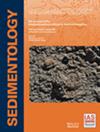Gravitational resedimentation as a fundamental process in filling fjords: Lessons from outcrops from a late Palaeozoic fjord in Namibia
IF 2.8
2区 地球科学
Q1 GEOLOGY
引用次数: 1
Abstract
Abstract The stratigraphic architecture of fjords is complicated due to the delicate interplay between ice dynamics, sediment supply, relative sea‐level fluctuations and slope failures. Glaciogenic sediment is prone to failure and to be carried downslope to the fjord floor through the entire spectrum of mass movements and subaqueous density flows, as the unstable paraglacial submarine landscape moves towards stability. Palaeofjords formed by Gondwanan glaciers during the late Palaeozoic Ice Age contain a compelling record of gravitational resedimentation in fjord depositional systems. This paper showcases the geomorphology and depositional history of a glacial cycle in the Orutanda fjord in north‐western Namibia as an example of an overdeepened fjord basin fill dominated by products of subaqueous gravitational processes. During glaciation, the Orutanda glacier carved a 20 km long by 3.7 km wide glacial trough that embodies an overdeepened basin. Ice thickness during terminal glacial occupation of the fjord is estimated to had been up to 200 m based on the fjord geomorphology. The progressive retreat of the tidewater glacier, concomitant with marine flooding, increased accommodation space in the overdeepened basin during deglaciation. During this stage, proglacial sedimentation through iceberg rafting and settling of turbid plumes was outpaced by intense paraglacial downslope resedimentation of glacially‐transported debris. Successive failures from the fjord walls and downslope resedimentation resulted in coalescing debrite–turbidite lobes on the fjord floor. Slide deposits, composed entirely of deformed debrites and turbidites, indicate that these resedimented facies were prone to renewed mass wasting. As the Orutanda glacier melted, the fjord experienced the axial progradation of a fjord‐head delta registered only by turbidites and slide deposits derived from its collapse. The Orutanda fjord sheds light on the relevance of paraglacial mass wasting in overprinting glaciogenic deposits. This insight is key to understanding the role of glaciers versus non‐glacial processes in producing the glacial deep‐time record.重力再沉积作为充填峡湾的基本过程:来自纳米比亚晚古生代峡湾露头的教训
由于冰动力、沉积物供应、相对海平面波动和斜坡破坏之间微妙的相互作用,峡湾的地层结构是复杂的。随着不稳定的副冰川海底景观趋于稳定,冰川沉积物很容易破裂,并通过整个质量运动和水下密度流动的频谱被带到下坡的峡湾底部。古生代晚期冰河时期冈瓦纳冰川形成的古峡湾在峡湾沉积体系中包含了引人注目的重力再沉积记录。本文介绍了纳米比亚西北部Orutanda峡湾的一个冰川旋回的地貌和沉积历史,作为一个水下重力作用主导的过深峡湾盆地填充物的例子。在冰河时期,奥鲁达冰川雕刻了一个长20公里,宽3.7公里的冰槽,形成了一个过深的盆地。根据峡湾的地貌特征,估计峡湾在冰川末期的冰厚可达200米。在消冰期,潮水冰川的逐渐退缩,伴随着海洋洪水,增加了过深盆地的容纳空间。在这一阶段,通过冰山漂流和浑浊羽状沉降的前冰沉积被冰川运输碎屑的强烈的滑冰期下坡再沉积所取代。峡湾岩壁的连续破坏和下坡的再沉积作用导致了峡湾底部的碎屑浊积叶片的合并。滑动沉积完全由变形的碎屑和浊积岩组成,表明这些再沉积相容易发生新的块状浪费。随着奥鲁达冰川的融化,峡湾经历了一个峡湾头三角洲的轴向递进,仅记录了由其崩塌产生的浊积岩和滑动沉积物。奥鲁达峡湾揭示了叠印冰川沉积中滑冰期物质消耗的相关性。这是理解冰川与非冰川过程在产生冰川深时记录中的作用的关键。
本文章由计算机程序翻译,如有差异,请以英文原文为准。
求助全文
约1分钟内获得全文
求助全文
来源期刊

Sedimentology
地学-地质学
CiteScore
8.20
自引率
11.40%
发文量
94
审稿时长
6-12 weeks
期刊介绍:
The international leader in its field, Sedimentology publishes ground-breaking research from across the spectrum of sedimentology, sedimentary geology and sedimentary geochemistry.
Areas covered include: experimental and theoretical grain transport; sediment fluxes; modern and ancient sedimentary environments; sequence stratigraphy sediment-organism interaction; palaeosoils; diagenesis; stable isotope geochemistry; environmental sedimentology
 求助内容:
求助内容: 应助结果提醒方式:
应助结果提醒方式:


